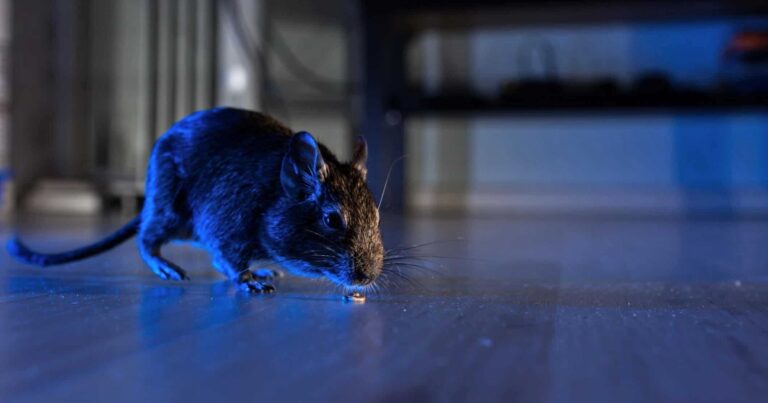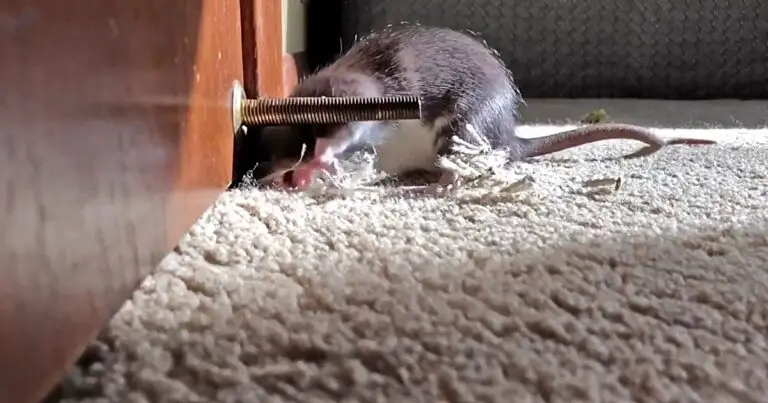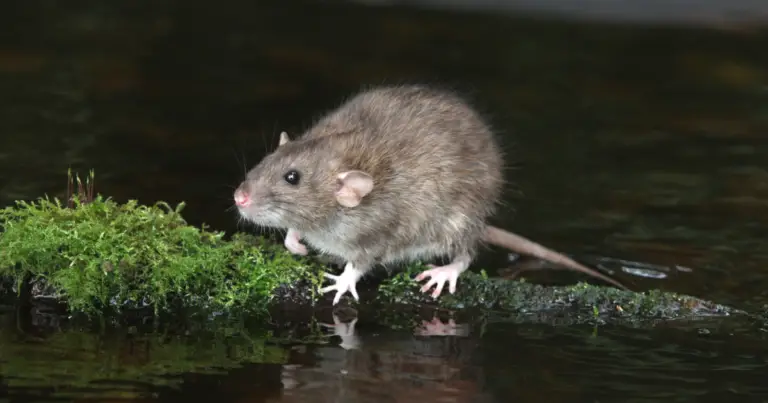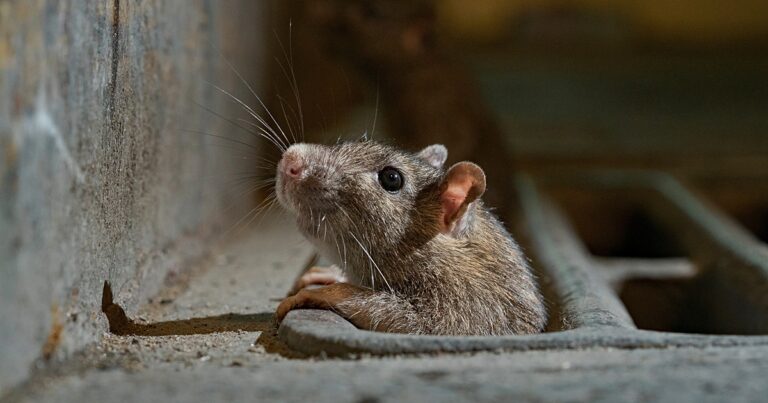What Can Rats Eat? (Diet of Unwelcome Guests)
Rats are omnivores, meaning they can eat both plants and animals. Typical rat diets consist of fruits, vegetables, nuts, insects, eggs and meat. Rats also feed on grains, seeds, pet food and birdseed. They may even scavenge scrounge for scraps in your garbage or compost bin. Overindulging in sugary treats or fatty snacks may lead to obesity in these tiny mammals.
If you have an unwelcome guest living in your home, it is important to limit their access to human food as much as possible to prevent them from becoming dependent on it for sustenance. Store all leftovers and uneaten items securely in airtight containers or the refrigerator so rats cannot get into them.
Although rats need a balanced and varied diet to stay healthy, they can survive on a wide variety of food sources.
What Can Rats Eat?
Rats can chew through all sorts of objects that they will not necessarily eat such as wiring, wood, insulation, cardboard, paper, and plastic.
However, rats tend to eat a balanced diet consisting of the following:
- Fresh fruits and vegetables such as apples, carrots, broccoli, kale, spinach and bell peppers
- Nuts like almonds and walnuts
- Oats and other whole grains
- Insects like mealworms and crickets
- Eggs
- Smaller animals such as mice, lizards, fish, and smaller rats.
Rats are not typically hunters, however, they will rely on predatory instincts if they are starving, feel threatened, and sometimes during the winter months.
Overall, it’s important to be aware that rats eat just about anything they can get their paws on. Keeping your unwelcome guests well-fed is key to keeping them out of trouble; while they are opportunistic feeders they do have preferences.
What Foods Are Toxic to Rats?
Rat poison is the top thing that rats should not eat. However, some foods can be quite toxic to rats as well. Any kind of food that is very high in fat, salt, and sugar or has a strong smell can be dangerous for rats to ingest.
Some foods that are toxic for rats include:
- Avocadoes
- Chocolate
- Citrus fruits
- Grapes
- Licorice
- Mangos
- Raisins
- Raw beans
- Raw potatoes
- Rhubarb
- Walnuts
In addition, raw potatoes, eggplant, and green tomatoes contain solanine which is poisonous to rats. That being said, these foods should not be fed to rats as they will continue coming for more even if it is not good for them.
Rats are opportunistic eaters and will eat nearly anything if they are hungry enough. If you have a rat infestation, keep all of your food stored in the fridge and tightly sealed glass containers. You should also always keep an eye out for any signs of rat activity.
How Long Can Rats Go Without Food?
Rats can usually survive for a week or two without having anything to eat. As they tend to store their food like squirrels, they have some reserve to last them for a while if the food source is cut off. However, rats are much more likely to scavenge and feed on whatever is available around them; including insects, food scraps, and sometimes even their offspring. This makes it extremely difficult to try and starve rats out of your home.
It is important to note that rats are very resilient and can survive in even the harshest conditions as long as they have access to food. They will eat just about anything and may even scavenge scrounge for scraps in your garbage or compost bin. Therefore, it is important to limit their access to human food as much as possible to prevent them from becoming dependent on it for sustenance.
What Can Rats Chew Through?
Most people measure that rat bites exert more force per square inch than alligators and sharks. Because of this, rats can chew through almost anything: wood, drywall, brick, concrete, aluminum, sheetrock, and more. When motivated, a rat can almost certainly make its way into your home using its powerful jaws.
It is important to note that the smaller the gap or opening in your walls or flooring boards, the easier it will be for a rat to enter. To prevent these unwanted guests from getting inside your home, you should check for small gaps around windows and doors as well as any cracks or crevices in your foundation or ceiling/floorboards.
Another interesting fact is that rats’ teeth are continuously growing, so they must constantly work to keep them short by grinding down the enamel. Chewing on hard objects like wood, metal, wires, and concrete can help them file their teeth down so that their teeth don’t grow through their jaws.
Can Rats Chew Through Metal?
Rats can chew through certain types of metal, but not all metals are equally vulnerable. Rats have strong teeth and jaws, and they can gnaw through materials like wood, plastic, and some types of metal, especially if they are motivated by the need for food or shelter.
Soft metals, such as aluminum, can be easily gnawed through by rats. Harder metals, such as steel, are more difficult for rats to gnaw through, but it is still possible for them to cause damage over time. For example, if a rat is motivated enough and has access to a steel structure, it may be able to gnaw through it by repeatedly biting and chewing in the same spot.
In general, it is important to take steps to prevent rat access to your home or building. This may involve sealing potential entry points, such as gaps around windows and doors, or holes in walls or foundations, and using rat-proof materials, such as steel mesh or metal flashing, to prevent rats from gnawing on metal surfaces.
Can Rats Chew Through Concrete?
Rats can gnaw on concrete, but they cannot chew through it. Concrete is a very hard and durable material, and it is not easily penetrated by rats or other rodents. However, rats have been known to gnaw on concrete surfaces in order to access food or shelter, and they may create small scratches or marks on the surface of the concrete.
In some cases, rats may also gnaw on concrete in order to create new entry points into buildings or to escape from captive situations. It is important to note that while rats cannot chew through concrete, they can find other ways to gain access to buildings or other structures. For example, they may climb walls, crawl through gaps or cracks, or squeeze through small openings.
To patch cracks in concrete created by rats, you can follow these steps:
- Clean the surface: Clean the surface of the concrete around the cracks, removing any dirt, dust, or debris.
- Fill the cracks: Use a concrete patching compound to fill the cracks. You can use a trowel to smooth the surface of the compound, making sure it is level with the surrounding concrete.
- Let it dry: Let the patching compound dry according to the manufacturer’s instructions. This usually takes a few hours, but may take longer depending on the conditions and the type of patching compound you are using.
- Sand the surface: Once the patching compound is dry, use sandpaper or a sanding block to smooth the surface and make it level with the surrounding concrete.
- Seal the surface: Apply a concrete sealer to the patched area to protect it from moisture and help prevent further damage.
Can Rats Chew Through Steel Wool?
Steel wool is a product made by twisting and tangling fine steel fibers together. It is typically used for cleaning or polishing surfaces, and it is not intended to be used as a building material. Steel wool is made of steel, which is a strong and durable metal, but it is not designed to be chewed or gnawed on by rats or other rodents.
The fine and tangled fibers of steel wool make it difficult for rats to bite into or gnaw through, and even if they could, the steel fibers would likely cause damage to their teeth. That being said, steel wool is not a suitable material for sealing holes or gaps in buildings to prevent rat access.
Rats are highly motivated to gnaw and chew, and they have been known to gnaw through a variety of materials, including wood, plastic, and even some types of metal. Steel wool can be compressed or unravelled, which would make it easier for rats to gnaw through. If you are looking to keep rats out of your home or building, it is best to use a material that is specifically designed for that purpose, such as steel mesh or metal flashing.
Can Rats Chew Through Chicken Wire?
Rats can potentially chew through chicken wire if they are motivated enough. Chicken wire, also known as poultry netting, is a type of mesh made of thin wire that is often used for fencing or to reinforce soft materials like plaster or stucco. While chicken wire is generally strong enough to keep poultry or small animals contained, it may not be strong enough to keep rats out.
If rats chew through chicken wire, it can result in damage to the mesh and potentially allow the rats to gain access to the area behind it. This can lead to further damage or destruction of property, and may also pose a risk to health and safety, as rats can carry diseases and parasites.
In a situation where chicken wire has been damaged by rats, it may need to be repaired or replaced in order to prevent further access by rats. If the chicken wire was being used to keep pests or animals out of a garden or other area, it may also need to be reinforced or replaced with a stronger material in order to maintain its effectiveness.
Can Rats Chew Through Aluminum Foil?
Yes, rats can chew through aluminum foil. Aluminum foil is a thin, soft metal that is easily damaged by rats’ sharp teeth and strong jaws. If a rat is motivated to gain access to a food source or to escape from a captive situation, it may be able to gnaw through aluminum foil.
However, aluminum foil is not commonly used as a material for construction or for blocking rat access, as it is not strong or durable enough to provide a reliable barrier. To prevent rat access to buildings or areas, it is recommended to use materials like steel mesh or metal flashing, which are specifically designed to keep rats out.
Can Rats Chew Through Plastic Containers?
Yes, rats can chew through some types of plastic containers. Rats have sharp teeth and strong jaws, which they use to gnaw through a variety of materials, including wood, metal, and plastic. The type of plastic, its thickness, and the size of the container will all play a role in determining if a rat can chew through it.
For example, thin or flimsy plastic containers may be easily gnawed through by rats, while thicker or more durable containers may provide more resistance. Hard plastic containers, such as those made from polycarbonate, are generally more difficult for rats to gnaw through than containers made from softer plastics, such as polyethylene.
If you have rats, it is important to store food in containers that are resistant to gnawing and chewing. Some recommended options include:
- Metal containers: Metal containers, such as metal cans or metal food storage containers, are highly resistant to rat gnawing. Steel and aluminum are the most commonly used metals for food storage containers, but they can be more expensive than plastic options.
- Hard plastic containers: Hard plastic containers, such as those made from polycarbonate or polypropylene, are more resistant to rat gnawing than containers made from softer plastics. Look for containers that are specifically labeled as being “rodent-resistant” or “gnaw-proof.”
- Glass containers: Glass containers, such as glass jars or glass food storage containers, are a good option for storing food if you have rats. Glass is not easily gnawed through by rats, and it is also easy to clean and disinfect.
How Long Do Rats Live After Eating Poison?
The length of time a rat will live after consuming poison depends on several factors, including the type of poison, the amount consumed, and the individual rat’s size and overall health.
Some types of rat poison can act quickly, killing rats within a few hours of consumption. Other types of poison may take several days to take effect. Some poisons cause death by internal bleeding, while others cause death by damage to the nervous system.
In general, it is recommended to wait several days after setting out poison to allow it to take effect and to clear out any dead rats. It is also important to follow all safety precautions and label instructions when using rat poison, and to dispose of any dead rats in a safe and responsible manner.
It is important to note that using rat poison can be hazardous to other animals, including pets, and to humans, especially if not handled and stored properly. If you have a rat problem, consider using alternative methods, such as trapping and removing the rats, or using physical barriers to prevent access to the area, before resorting to poison.
Conclusion
Rats have sharp teeth and strong jaws, which they can use to gnaw through a variety of materials. Aluminum foil is not typically recommended as a material for blocking rat access because it isn’t durable enough.
To prevent rats from accessing buildings or areas, steel mesh or metal flashing should be used instead. Rats are also able to chew through some types of plastic containers depending on their thickness and the size of the container. Hard plastics such as polycarbonate or polypropylene may provide more resistance than softer plastics like polyethylene.
If you have rats, consider storing food in metal cans, hard plastic containers specifically labelled “rodent-resistant” or “gnaw-proof,” glass jars, or other options that are resistant to rat gnawing.









2 Comments